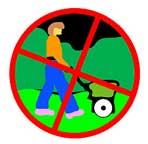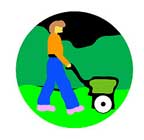|
|
 |
||
|
Volume 13, Issue 15 ~ April 14 - 20, 2005
|
|||
 The Grass Is Always Greener on the Other Side of the Fence The Grass Is Always Greener on the Other Side of the Fenceby Maureen Miller The sun is climbing farther north these days, rising earlier and setting later. It’s warming the earth, allowing daffodils and tulips to gaily pop their heads from underground. Viewing these reminders of the approaching growing season, my eyes turn toward that patch of green surrounding my home: my lawn. When I first moved to Bay country, there was no question as to whether I should fertilize my lawn in the spring. Just as I supplement my diet with a daily dose of vitamins, so too did I supplement my soil with a twice-yearly dose of growth-providing nutrients. My only question was the type of fertilizer I would use, chemical or organic. I poured over the disadvantages of chemical fertilizers: leaches readily, danger of fertilizer burn, high salinity potential, must be applied frequently at low rates, usually acid forming. Then I reviewed the disadvantages of organic fertilizers: not released readily in cold weather, slow response, may contain weed seeds and can be expensive. Spreading chemical fertilizer on my lawn goes against my desire to preserve the marshes and creeks that feed our precious Bay. Thus, twice each year in spring and fall, I repeat the four-hour job of pushing my spreader back and forth, dropping organic fertilizer granules across my 1,500 square-foot lawn. As per the fertilizer instructions, I follow this up with a good dose of water to ensure that the fertilizer begins to do its job — unless, of course, it’s scheduled to rain in the next 24 hours. The organic fertilizer costs a bit more — $120 for the two applications of fifty pounds. Still, my yard is just as green as any other in my neighborhood.  Stopped in My Tracks Stopped in My TracksBut when I queried Bay Weekly editor Sandra Martin on a story comparing chemical to organic fertilizer, she set me thinking. “Why spread any fertilizer on your yard?” she asked. “Especially if your concern is the effects of fertilizer on the Bay.” “Anyone who wants a green lawn fertilizes,” I said. Then I started thinking. Does my lawn really need fertilizer? If so, how much? And when? So off I went to find some new answers, while keeping a running total in terms of costs. Challenging the Fertilizer Assumption Americans manage more than 30 million acres of lawn and spend $750 million per year on grass seed, according to the Alliance for the Chesapeake. Trying to put these statistics into perspective, I discovered that’s enough lawn to cover Pennsylvania. And our national seed money amounts to more than three-quarters of Maryland’s state operating budget for 2005. To keep those 30 million acres green, we use 100 million tons of fertilizer and more than 80 million pounds of pesticides. Next I considered how much fertilizer we lawn-loving homeowners use compared to the fertilizer used by farmers, who get the blame for contributing 41 percent of the Bay’s nitrogen overload. A decade ago, the Environmental Protection Agency found that lawnowners used more pounds of fertilizer per acre than the average farmer. Our pesticide use is even more wanton, amounting to 10 times the rate per acre of pesticides applied by farmers. By now, I was beginning to get alarmed. What’s all that fertilizer I’ve been applying over the years actually doing? I soon discovered that it could be harming the very lawn I’m cultivating. When fertilizer is spread at the wrong time or in the wrong amount, it can cause lush, rapid growth that is prone to disease and more attractive to pests. And that’s only the fertilizer that seeps down to the roots, for lawns are not sponges, and much fertilizer is untimely washed away before the grass can take it up. I began worrying that a good part of the $120 that I’d been spending on my mail-order, organic fertilizer each year was being washed down the drain. Far more importantly, could my organic fertilizer actually be harming the Bay? According to the Maryland Cooperative Extension Home and Garden Center, nitrogen and phosphorous, two key ingredients in fertilizers, organic or chemical, are also the top two nutrient pollutants of Maryland waterways. These pollutants cause the loss of underwater grass beds — critical habitat for Bay creatures — and rob the water of oxygen that is critical to aquatic life. About one-half of excessive or misapplied nitrogen fertilizer enters surface water quickly as runoff from hard surfaces, lawns and gardens. The other half travels for at least 10 years through the soil before eventually entering the Chesapeake Bay or its tributaries. This got my attention. I never dreamed that my fertilizing habits could harm the Bay a decade in the future. Karl Blankenship, editor of the monthly Bay Journal, the newspaper of the Alliance for the Chesapeake, sums up my new-found concerns about fertilizing and our Bay’s health: “Although fertilizer from lawns is a relatively small source of nutrients to the Bay, it is one that can be easily controlled by individuals and, as the region becomes more developed — with more lawns — it is a pollution source likely to grow.”  Why Fertilize? Why Fertilize?Fertilizers have been added to the soil to help plants grow for thousands of years. Long before our ancestors understood plant nutrition, they noticed that animal droppings, wood ashes and certain minerals helped plants thrive. It was not until the early 1900s, however, that scientists identified the chemical elements essential for plant nutrition. In science class we learned that green plants produce the food they use via photosynthesis. Photosynthesis requires large amounts of nine elements — carbon, hydrogen, oxygen, nitrogen, phosphorus, potassium, calcium, magnesium and sulfur — as well as smaller amounts of several other elements. While air and water provide most of the carbon, hydrogen and oxygen, the other elements must come chiefly from the soil. If the soil is lacking in any of these elements, or has only trace quantities, plants suffer. Lawns primarily need nitrogen, phosphorus and potassium for proper growth. Nitrogen gives the grass its green color and promotes root and shoot growth. Phosphorus helps roots develop. Potassium builds disease resistance, winter hardiness, drought tolerance and helps the grass recover easily from human feet trampling it. Over the years, various types of fertilizers have been formulated to provide nutrients for green and disease-resistant lawns. With such fertilizer variety, how do I decide what type my lawn needs and how much to buy? Taking a trip to my local lawn and garden store, I walked the fertilizer aisles. The store’s lawn expert greeted me and asked whether I want a liquid or granular fertilizer, a chemical or organic fertilizer, a quick- or slow-release fertilizer. Checking the labels on the bags and boxes, I saw numbers like 10-6-4, 5-10-5 and 10-10-10. The first number, the lawn expert tells me, represents the percentage of nitrogen, the second the percentage of phosphorous and the third the percentage of potasium. Other numbers on the bag indicate the source of nutrients and whether the nitrogen is of the quick-release or slow-release form. My head was spinning. Sensing my confusion, the expert asks, “What were the results of your soil test?” That’s when I fled the store, deciding instead to go with a mail-order organic fertilizer. In hindsight, it may not have been the right choice, but at the time, it was the easy way out. Ask Your Soil Repeatedly, as I tracked answers through a nation of State Extensions, I encountered the same question: Has your soil been tested in the last three years? Ah … not exactly. In truth, the last time my soil was tested was before my lawn was put in eight years ago. Since then, I’ve been spreading my organic fertilizer every spring and fall, as the garden-supply company I deal with recommends. Why should you test your lawn’s soil every three years? “If the soil in your lawn has a pH below 5.5, you’re wasting fertilizer, which means that you have increased your chances of contributing to the pollution of the Bay,” says University of Maryland professor emeritus Frank Gouin, Bay Weekly’s gardening columnist. “It’s not uncommon to have soils in the Bay area with pH’s down to 4.5 and below.” Soil pH is a measure of how acidic (sour) or basic (sweet) your soil is. It directly affects the nutrient availability and thus what fertilizer is — or is not — needed. Fertilizers, I soon learned, are regulated at the state level because soil conditions vary dramatically from state to state and across the country. Thus, farmers and commercial lawn companies are required by the state of Maryland to perform soil tests before applying any fertilizers. However, a survey taken by the Prince William Cooperative Extension in Virginia found that less than 20 percent of residential lawn growers have their soil tested to determine their lawns’ specific nutritional needs. Those who do have their soil tested often discover that they don’t need to apply as much fertilizer as they thought or that other soil amendments (such as lime) will give them the greener lawn they desire. Again, I compared poorly to my neighboring farmers, who routinely test their soils before fertilizing for ecological and economic reasons, as well as for regulatory requirements. Why should I hold out? Testing, I discovered costs as little as $6 [see sidebar on testing labs] and begins with taking small samples from several places in the yard. This is done because some parts of your yard may be more deficient than others and thus need regular applications of fertilizer, while other areas may need few or even no applications. In each unique area, you take several soil plugs from your lawn. Using a clean trowel or shovel, dig down four inches and remove a one-inch-thick slice from the smooth side of the open hole. Remove the sides of the slice, leaving a ribbon of soil two inches wide and one inch thick. Remove all grass, rocks and debris from the sample and set it in a clean bucket. Take additional soil sub-samples from the same unique area and mix them together to create a composite example. Then box the composite samples up and send them to the laboratory. (Soil testing laboratories provide free soil sample boxes and complete information on how to take the samples.) After the soil is analyzed, you receive a lab report listing the amounts of each nutrient in each sample and making recommendations for major nutrients as well as determining your soil’s pH and offering recommendation on how to raise or lower it. This is exactly what I need to take the guesswork out of fertilizing, and the soil test costs only $6 and requires roughly an hour of time. Even with the hour spent sampling my soil and mailing off the test kit, I’ll have at least three extra hours to spend on spring chores this year. That’s because I’ll be keeping my fertilizer spreader in the garage. That’s the conclusion I was about to reach on my own when I heard the Chesapeake Club’s recommendation: “Hold off on fertilizing until fall to avoid creating weak roots.” The club, an outreach initiative of the Chesapeake Bay Program, is conducting an advertising campaign this spring urging lawn-tenders to reduce fertilizer use on their grass to help the Bay and the creatures that live in it — particularly blue crabs. The advice is nothing new; what’s new this year is such self-interest messages No appetizers were injured in the making of this lawn and The lunch you save may be your own. “We chose this campaign as a way to reach the general public that may not have realized a personal connection to the Bay,” said Bob Campbell, National Park Service liaison to the Bay Program and chair of the Bay Program’s Communications and Education Subcommittee. “If we can make skipping the fertilizer and having a healthy Bay fun, easier and popular, we are going to be able to achieve what we want.” Put Clippings to Work I was just about convinced. My final worry — that my lawn wouldn’t get all the nutrients it needs — was set to rest by one word from the Maryland Cooperative Extension Home and Garden Information Center: grasscycle. Leaving grass clippings where they fall — that’s all grasscycling is — slowly releases free nutrients to the soil and stimulates biological activity. You may have heard that grasscycling contributes to thatch buildup or spreads disease; both are myths. In fact, grasscycling cuts fertilizer needs by as much as three-fourths — though only testing will tell you exactly what your lawn needs.  Grasscycling also saves time as you needn’t bag or rake. It helps protect the environment by reducing the amount of lawn clippings in the landfill. Grasscycling also saves time as you needn’t bag or rake. It helps protect the environment by reducing the amount of lawn clippings in the landfill.So it looks like I’ll be saving still more time, as I let my lawnmower do the mulching and keep the rake in the garage with my fertilizer spreader. About the Author Maureen Miller moved to Galesville for the natural peacefulness it offered in juxtaposition to her job with an international organization in D.C. She has written for Bay Weekly on yoga and tai chi. Her last feature, “Sailing for the Finish Line: The Wednesday Night Races,” ran in July of 2004.
|
|||
|
© COPYRIGHT 2004 by New Bay Enterprises, Inc. All rights reserved. |
